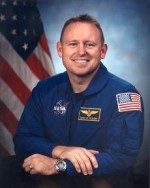
Tech alumnus and NASA astronaut Barry Wilmore will be heading to space through the STS-129 Mission.Wilmore, a Mt. Juliet native, graduated from Tech in 1985 with his undergraduate degree in electrical engineering. While attending Tech, he played football, and in 2003 was inducted into Tech’s “Sports Hall of Fame.”
Upon graduating, he applied to the US Navy, but failed the physical due to a football-related knee injury.
Wilmore then made the decision to use his remaining year of football eligibility while attending graduate school.
“Looking back, those [years at Tech] were the hardest years of my life because the good Lord didn’t give me a brain that could grasp things immediately,” said Wilmore in a preflight NASA interview. “I had to study, and I had to study hard, and as I look back, I was either studying or I was on the football field.”
After proving himself healthy in several physicals, the Navy accepted him.
Wilmore flew 21 missions in Operation Desert Storm while stationed on the USS Kennedy. He also participated in the initial development of the T-45 jet trainer as a Navy test pilot.
He completed his masters in 1994 because he promised his mother he would.
Before being selected by NASA, Wilmore was on exchange with the Air Force as a flight test instructor.
He was chosen as a candidate by NASA in 2000 and had to complete two years of training before becoming an astronaut.
After his training, Wilmore was assigned technical duties dealing with population system issues including the space shuttle solid rocket motor, external tank and main engines.
He found out fall 2008 that he would be piloting space shuttle Atlantis for the STS-129 mission. Wilmore credits Tech with helping him develop the skills that led to this assignment.
“Every tool I need I got at Tech,” said Wilmore in an interview with “Visions,” Tech’s alumni magazine. “From chemistry to physics to football, it all helps me.”
Tech has been the school of choice for more than one member of the Wilmore family. Beth Ann Wilmore and James Wilmore, Wilmore’s niece and nephew, both attend Tech.
“He has inspired me in many ways,” said Beth Ann Wilmore, a sophomore nursing major. “Uncle Barry has always been there to cheer me on and uplift me.”
“I had the opportunity to intern at NASA this summer and we [he and Wilmore] ran and lifted weights every morning at 5:30,” said James Wilmore, a senior pre-med major. “I also was able to observe him and his crewmates train for their mission. I realized that these men didn’t only work hard to get to where they are-they were the best at everything they did.”
Wilmore has accumulated over 5,900 flight hours and 663 carrier landings, all in tactical jet aircrafts, and has received multiple aviation honors.
He will make history as the pilot of the last space shuttle crew rotation flight to or from the space station.
About the mission
Charlie Hobaugh is commander of STS-129 with Robert Satcher, Michael Foreman, Randy Bresnik, and Leland Melvin serving as mission specialists. This will be the first space trip for Wilmore, Satcher and Bresnik.
The STS-129 mission-the 31st to the ISS-is to deliver experiment racks and two spare gyroscopes to the ISS. Because it is the first mission to be devoted to transporting spare parts, it will carry those of highest priority.
The parts are going up on two platforms, called external logistics carriers, or ELCS. It is hoped that wherever a failure happens, the needed spare will be close by.
“You’ll see this theme in some of the flights that are going to come after ours as well,” said Brian Smith, lead ISS flight director STS-129, in a preflight interview. “This flight is all about spares – basically, we’re getting them up there while we still can.”
There will be 27,250 pounds of parts to keep the ISS going after the space shuttles retire.
STS-129 will also feature three spacewalks and is slated to bring station crewmember Nicole Stott back to earth.
Where other space shuttles have been outfitted with a system that allows them to draw power from the space station, Atlantis was not. This means the shuttle has just 11 days to get to the station and back.
The six astronauts will be under quarantine at the JSC for three days before flying to Kennedy Space Center on Thursday for Atlantis’ launch.
The mission is set to launch at 2:28 p.m. on Monday, four days later than previously scheduled. If it is delayed again, the downlink will also be subject to postponement.
Melvin and Satcher are expected to provide updates on their Twitter accounts during the shuttle mission.
The ISS has been continuously occupied by humans since Nov. 2, 2000, and is a partnership of the U.S., Russian, European, Japanese and Canadian space agencies.
“Nothing like this has ever taken place before and I think regardless of what we do on station… we’ve made great strides, even politically,” said Wilmore in the same preflight interview. “Even in that aspect, if you think about parts that are built and constructed in Japan, Italy, Europe and Russia. all these components come together, and they work together. It is indeed remarkable.”
Upon completion in 2010, it will have a crew of six conducting research in preparation for future space exploration.
For more information about NASA’s Space Shuttle Program, Inflight Education Downlink Program or for complete astronaut biographical information, visit www.nasa.gov.


